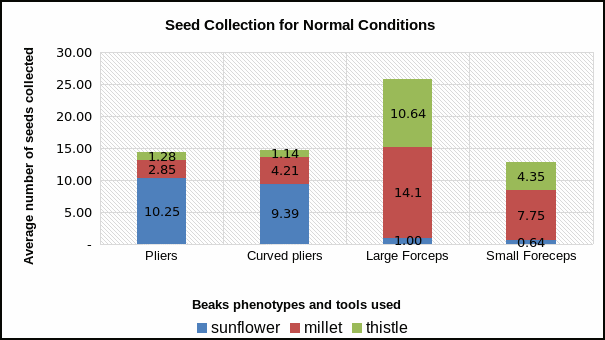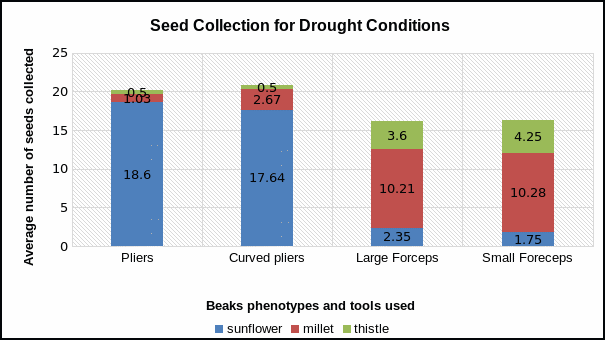Abstract
The environmental conditions and the nature of seeds available have influenced the evolution and adaptation of finches’ beaks to their feeding habits. The goal of the study was to demonstrate how different beaks influence feeding habits of finches. In this view, the study hypothesized that the small beaks prefer picking small-sized seeds (millet) while large beaks prefer picking larger seeds (thistle). The experiment simulated four beaks, namely, normal pliers, curved pliers, large forceps, and small forceps, which were used in picking sunflowers, millet, and thistle seeds.
Phenotypic characteristics of beaks are important for they influence the feeding habits and determine the survival ability of finches. The key results that led to the rejection of the hypothesis that the small beaks prefer picking small-sized seeds (millet) while large beaks prefer picking larger seeds (thistle) indicated that small pliers and curved pliers prefer sunflower seeds while large forceps and small forceps prefer millet seeds. Thus, the conclusion is those small pliers and curved pliers can easily pick seeds with thin shells such as sunflower seeds while large forceps and small forceps can easily pick seeds with hard shells such as millet.
Introduction
Darwin’s theory of evolution posits that living things are constantly evolving in response to selection pressure. As the environment changes, the native species adapt to their habitat conditions by evolving new inheritable physical/behavioral traits (Podos and Nowicki 506). The evolution of finches illuminates the changes in recent earth’s biodiversity and enhances understanding of the role of genetic diversity. Darwin finches comprise of over 13 passerine bird species native to the Galapagos Islands, South America (Grant and Grant 135). Darwin’s finches show remarkable evolutionary changes that allow them to occupy different niches in similar habitats. The finches evolved distinct beak types to adapt to different diets in response to selection pressure. The beak type determines each bird’s access to a particular food source available in its natural habitat, such as the Galapagos Islands. Podos and Nowicki note that the evolution of different beak sizes/types ensured that up to 15 different species of finches could coexist in the islands (507). While some evolved long, slender beaks suitable for eating insects, others developed shorter, thicker beaks for feeding on seeds of different sizes.
The theory of natural selection dictates that organisms must adapt to their habitats to survive (Grant and Grant 135). It produces heritable biological variations that could be favorable, deleterious, or neutral. The accumulation of advantageous traits makes a species fit to compete and survive in changing habitats. The underlying assumptions of this theory include a natural variation that produces desirable, unfavorable, or neutral traits, inheritance, and survival for the fittest (Podos and Nowicki 509). Therefore, Darwin’s finches evolved different beaks to feed on different food sources as an adaptive strategy.
For this experiment, the aim was to demonstrate how different beak types/sizes, represented by normal pliers, curved pliers, large forceps, and small forceps, determine each bird’s access to seeds of variable sizes. We hypothesized that the small pliers would pick small-sized seeds (millet) more quickly than tongs, which would be suited for picking larger seeds (thistle). The underlying rationale is that each beak size (tool) is suited for picking a particular seed size, which would explain the variation in total seed collections at the end of the experiment. The experiment helped mimic how selection pressure drives evolutionary changes in organisms.
Methods
In the experiment, we simulated natural selection in finches, where the ‘beak’ type determined the ability to compete for different forms of food sources, such as sunflower, millet, and thistle. The experiment involved four types of ‘beaks’ represented by normal pliers, curved pliers, large forceps/tongs, and small forceps. The simulation involved using the beaks to pick or ‘eat’ different types of seeds, which included sunflower, millet, and thistle.
Seven groups of participants simulated different ‘beaks’ to mimic beak adaptations in the Darwin finches. Each participant was required to use different beaks in picking different types of seeds throughout the experiment. The seeds (100 from each type) were counted and mixed on a desk. Using the assigned beak in each round, each participant ‘ate’ as many seeds of a particular type as possible within one minute. The seeds ‘eaten’ were placed in a collection cup for each trial. Each individual experiment was repeated four times (trials) for each condition. The experiment involved two treatment arms, that is, normal and drought conditions. An average of the seeds collected in each cup represented the number of seeds ‘eaten’ by individual beaks within one minute. Experiment data were collected, recorded, and combined with other trials to be analyzed using Excel.
Results
The results of the experiment comprise an average number of seeds picked by each type of beak in different conditions. The results showed that the number of seeds picked by finches varied according to the type of beaks and the environmental conditions. The data in Figure 1 shows that under normal environmental conditions, small pliers picked an average of 10.25 sunflower seeds, 2.85 millet seeds, and 1.28 thistle seeds. Under the same environmental conditions, curved pliers picked an average of 9.39 sunflower seeds, 4.21 millet seeds, and 1.14 thistle seeds. The average numbers of sunflower seeds picked by large forceps and small forceps were 1 and 0.642 respectively. Additionally, the average numbers of millet seeds picked by large forceps and small forceps were 14.1 and 7.75 whereas those of thistle seeds were 10.64 and 4.35 respectively.
Figure 1 shows that small pliers and curved pliers preferred sunflower seeds followed by millet seeds whereas thistle seeds had the least preference during the normal conditions. Moreover, during the normal conditions, large forceps and small forceps preferred millet seeds followed by thistle seeds while sunflower seeds had the least preference.

Comparatively, it is apparent that the average numbers of seeds picked by different beaks during drought conditions (Figure 2) follow the same trend as during normal conditions. The average numbers of seeds picked by small pliers are 18.6, 1.03, and 0.5 whereas those of curved picks are 17.64, 2.67, and 0.5 for sunflower, millet, and thistle respectively. The average numbers of seeds picked by large forceps are 2.365, 10.21, and 3.6 while those picked by small forceps are 1.75, 10.28, and 4.25 for sunflower, millet, and thistle correspondingly. Figure 2 also depicts that small pliers and curved pliers prefer sunflower seeds whereas large forceps and small forceps prefer millet seeds during the drought conditions.

Discussion
As the goal of the study was to demonstrate how different beaks influence feeding habits of finches, the results provide invaluable information about the adaptation of finches’ beaks. The results reveal that the average number of seeds picked varied according to the type of seed, type of beak, and the environmental condition. The apparent trend is that during both the normal and drought conditions, beaks had similar preferences of seeds. For instance, during the normal conditions and the drought conditions, small pliers and curved pliers preferred sunflower seeds while large forceps and small forceps preferred millet seeds.
Overall, millet seeds are seeds picked with the highest frequency during the normal conditions while sunflower seeds are seeds with the highest frequency during the drought conditions. However, the frequency was not consistent for all types of beaks because the frequency of sunflower seeds was the highest among small pliers and curved pliers while the frequency of millet was the highest among large forceps and small forceps during both the normal and the drought conditions.
The most adaptive beak is small forceps because it prefers both millet and thistle seeds and the environmental conditions do not significantly influence the frequency of its preferred seeds. According to Grant and Grant, finches acquire adaptive features that allow them to feed on different seeds depending on the environmental conditions (133). A comparison of the seeds ‘eaten’ at the highest frequency during different environmental conditions indicates that the highest frequency increased during the drought conditions. The reason for the increase in the highest frequency is that drought conditions allow finches to utilize their adaptive abilities to crack preferred seeds (Podos and Nowicki 501). The experience of drought led to the selection of small pliers, curved pliers, and small forceps for adaptation because of the increased frequency of seeds picked whereas large forceps were selected against adaptation due to the decreased frequency of seeds picked.
The collected do not support the hypothesis that the small pliers would pick small-sized seeds (millet) more quickly than tongs, which would be suited for picking larger seeds (thistle). The results indicate that small pliers and curved pliers easily pick sunflower seeds while large forceps and small forceps easily pick millet seeds. In conclusion, the results show that small pliers and curved pliers can easily pick seeds with thin shells such as sunflower seeds while large forceps and small forceps can easily pick seeds with hard shells such as millet.
Works Cited
Grant, Peter and Rosemary Grant. “Adaptive Radiation of Darwin’s Finches.”American Scientist, vol. 90, no. 2, 2002, pp. 130-139.
Podos, Jeffrey and Stephen Nowicki. “Beaks, Adaptation, and Vocal Evolution in Darwin’s Finches.” Bioscience, vol. 54, no. 6, 2004, pp. 501-511.